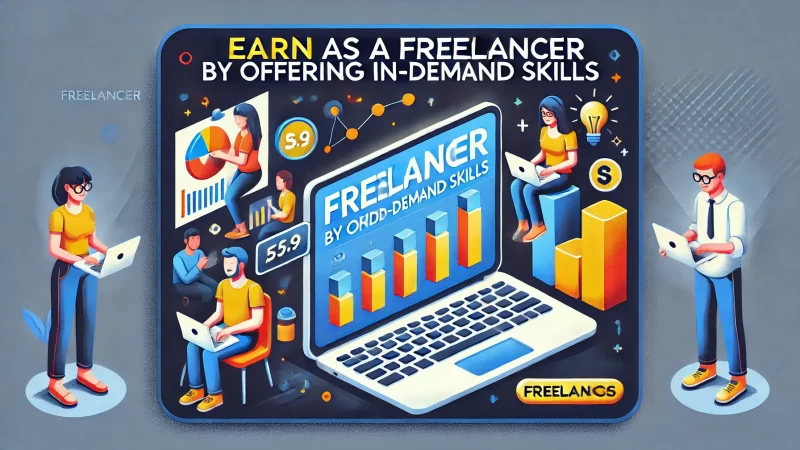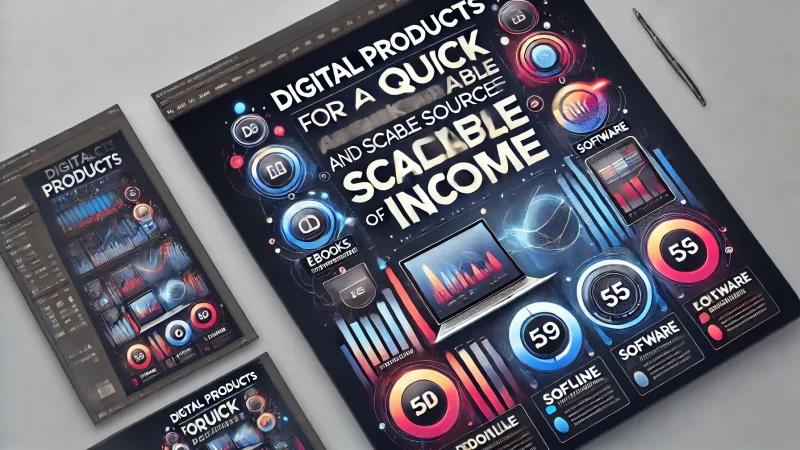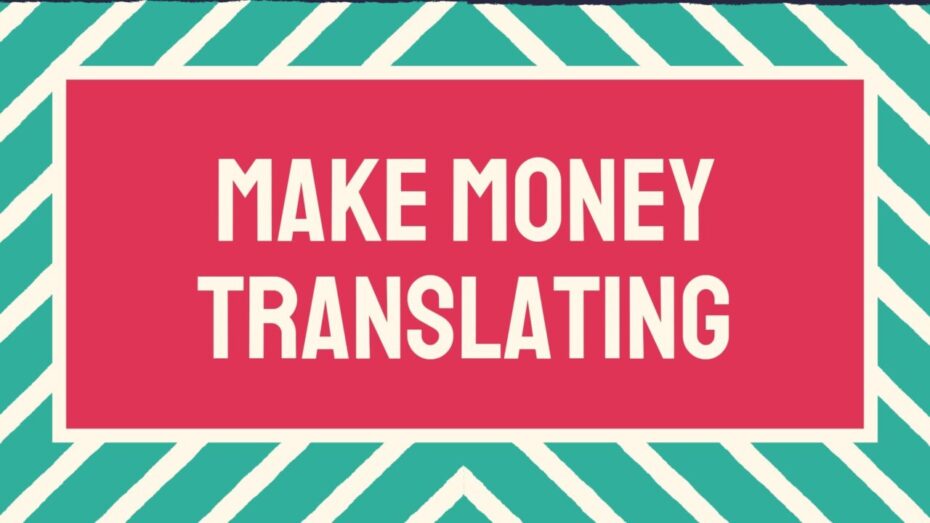Are you feeling broke and wondering how to make some money fast? What if I told you that the digital world offers a range of exciting opportunities, from affiliate marketing to freelancing, that can turn your financial situation around?
Whether you’re looking for a side hustle or a full-time income, this guide dives into actionable steps and strategies that can help you tap into the growing world of online business and entrepreneurship. Discover how you can start earning with little investment and, more importantly, how you can build a long-term, sustainable income stream.
1. Tap Into Affiliate Marketing Opportunities For Easy Earnings

Affiliate marketing offers an easy way to make some money without needing to create your own products. It revolves around promoting third-party products and earning a commission for each sale made through your unique affiliate link. I’ve found that once you set up the system, it’s a low-maintenance, scalable source of income.
What I love most about affiliate marketing is its simplicity and the variety of programs available. You don’t need a huge following to get started. I suggest focusing on promoting products you believe in and using trusted affiliate networks, which I’ll explore further below.
How Does Affiliate Marketing Help You Make Some Money?
Affiliate marketing helps you make some money by tapping into established products and services. You earn a commission each time a user makes a purchase through your referral link. It’s a performance-based system, so you get paid for results, not just clicks or views.
What makes it appealing is that you don’t need to deal with customer service or handle inventory. All you do is promote and refer. The potential for growth is endless, especially as you build an audience that trusts your recommendations. I recommend starting with smaller, niche products before promoting larger, high-ticket items.
Because affiliate marketing doesn’t require significant upfront investment, anyone can start with a blog, YouTube channel, or even social media. By consistently providing value and promoting relevant products, your affiliate revenue can grow steadily. What’s better is that the more effort you put in, the more passive income you can generate over time.
Steps To Get Started With Affiliate Marketing Programs
To get started with affiliate marketing, I suggest first choosing a niche that you’re passionate about. Focusing on a specific niche helps you build trust and authority, making it easier to recommend products to your audience. Once you’ve selected a niche, research affiliate programs within that space.
Sign up for well-established affiliate programs or networks such as Flexoffers, ShareASale, or MyLead. You’ll then receive affiliate links that track referrals from your promotions. I recommend placing these links strategically across your content to encourage conversions. You can integrate them into blog posts, videos, or emails.
The next step is creating content that highlights the benefits of the products you’re promoting. This could be in the form of product reviews, how-to guides, or even social media shout-outs. The key is to provide real value while subtly incorporating your affiliate links, rather than focusing solely on selling.
Consistency is crucial. Make it a habit to track your affiliate performance through metrics like clicks, conversion rates, and revenue. By analyzing this data, you can refine your strategy to improve your earnings. Scaling your efforts becomes easier as you discover what works best for your audience.
Best Affiliate Networks To Maximize Income
To maximize your affiliate marketing income, I suggest joining reputable affiliate networks. These platforms connect you with thousands of merchants across various industries, offering flexibility and earning potential. One popular network is ShareASale, known for its vast array of merchants and reliable payouts.
Amazon Associates is another favorite. It’s beginner-friendly, offering millions of products to promote, but the commission rates are generally lower. For high-ticket affiliate programs, I suggest trying ClickBank or CJ Affiliate, which offer higher commissions on digital products like courses or software.
Rakuten Advertising and Impact are also worth exploring. These platforms cater to niche industries and often feature exclusive products, giving you a competitive edge. Diversifying your affiliate networks not only increases your income streams but also allows you to tap into different audience segments.
Joining multiple networks is advantageous because each platform offers different commission structures and product categories. I recommend experimenting with a few, tracking performance, and eventually focusing on the ones that yield the best results.
How To Choose The Right Products For Affiliate Success
Choosing the right products for affiliate marketing is crucial for long-term success. I recommend focusing on products that resonate with your audience and solve a problem they’re facing. The more relevant the product, the more likely your audience will trust your recommendations and make a purchase.
Additionally, consider the commission structure. High-ticket items or subscription-based products often offer recurring commissions, allowing you to make some money long after the initial sale. For instance, promoting a popular software subscription can generate steady income, as users renew their memberships.
I also advise researching product reviews and testing products yourself if possible. Promoting low-quality products can harm your reputation and trust with your audience. By recommending only high-quality items, you’ll build credibility and encourage repeat customers. Always look for products with high conversion rates and strong customer feedback.
Finally, stay updated on industry trends and new product launches. By being among the first to promote a trending product, you can capture a larger share of the market before it becomes saturated. Regularly revisiting your product portfolio ensures you’re always offering the best options to your audience.
2. Email Marketing For Consistent And Passive Income Streams

Email marketing is another powerful method to make some money consistently. By building a targeted email list, you can promote products, services, or content directly to your audience. What I love about email marketing is its potential to generate passive income through automated campaigns that work even while you sleep.
Emails allow you to connect on a personal level with your audience. You can nurture relationships, share valuable insights, and promote affiliate products or digital services over time. With the right strategy, I’ve found email marketing to be a sustainable and profitable revenue stream.
How Email Marketing Can Help You Make Some Money
Email marketing helps you make some money by allowing you to send targeted messages to a list of subscribers who’ve shown interest in your offerings. By segmenting your audience based on their interests, you can promote relevant products, services, or courses that resonate with them, leading to higher conversion rates.
I recommend using emails to build trust with your audience by consistently delivering value. This could be through free guides, exclusive deals, or useful tips. Once you establish trust, promoting products becomes much easier, and subscribers are more likely to purchase what you recommend.
Automated email sequences can be particularly effective. These are pre-written emails triggered based on user actions, such as signing up for a newsletter or clicking a link. With proper automation, you can generate a steady flow of passive income, as your emails continue working for you long after they’ve been sent.
Building An Effective Email List From Scratch
Building an email list from scratch may seem daunting, but it’s simpler than you think. I suggest starting by creating a lead magnet—something valuable like a free ebook, cheat sheet, or webinar that you can offer in exchange for email addresses. People are more likely to subscribe if they get something of value upfront.
Next, promote your lead magnet through multiple channels such as your blog, social media, and even guest posts. I’ve noticed that embedding opt-in forms directly within content or using pop-ups on your website significantly boosts sign-ups. Make sure your opt-in form is simple and user-friendly.
Focus on nurturing your list from the start. Avoid bombarding your subscribers with constant promotions. Instead, I recommend sending regular emails with valuable content, including tips, industry insights, or personal experiences. This builds trust and keeps subscribers engaged, making them more receptive to promotional offers.
Over time, I suggest segmenting your list based on user behavior. For instance, some subscribers might prefer product recommendations, while others are more interested in educational content. By tailoring your emails to specific segments, you’ll see better engagement and higher conversion rates.
Lastly, use email marketing software like Aweber, ConvertKit, or Mailmunch to manage your list and create automated workflows. These tools simplify the process, helping you track performance and optimize your campaigns for better results.
Strategies For Crafting Compelling Email Campaigns
Crafting effective email campaigns is key to making money with email marketing. I recommend starting with an engaging subject line that grabs attention immediately. Personalization is also important—using a subscriber’s name in the subject line or body can increase open and click-through rates.
In the body of your email, focus on providing value first before introducing a sales pitch. I suggest telling a story or sharing a personal experience related to the product or service you’re promoting. Keep your emails concise and focused, with a clear call to action at the end.
Visuals can enhance your message. Including product images, infographics, or video links can make your email more engaging. However, I advise not overloading your email with too many images, as this can affect deliverability. Balance is key.
I also recommend A/B testing different elements of your campaigns. Try testing various subject lines, email formats, or call-to-action buttons to see what resonates best with your audience. This data can help refine future campaigns for higher engagement and conversions.
Lastly, create a sense of urgency. Limited-time offers or exclusive discounts can encourage subscribers to take action immediately, boosting your sales. Be sure to include this urgency in both your subject line and body to maximize the effect.
Best Email Marketing Platforms To Boost Earnings
Choosing the right email marketing platform is essential to maximizing your income potential. I recommend starting with platforms that offer comprehensive tools to automate your campaigns and track performance. ConvertKit is a top choice for creators and bloggers, offering excellent automation features and segmentation options that allow you to target your audience effectively.
ConvertKit simplifies the email creation process and integrates well with most platforms, allowing you to embed opt-in forms across your blog or social media. I’ve seen how its intuitive interface helps both beginners and seasoned marketers launch campaigns with ease. You can create customized email sequences that nurture your subscribers and drive conversions.
Mailchimp is another popular option, especially for those just starting. It provides a free plan for smaller lists and easy-to-use drag-and-drop builders for creating emails. One standout feature is the wide range of templates available, allowing you to design visually appealing emails that resonate with your audience, encouraging them to take action.
For those looking for advanced features, ActiveCampaign is an excellent choice. This platform is known for its robust automation workflows and detailed customer tracking. It’s ideal if you want to send highly targeted campaigns based on user behavior, ensuring that your emails are relevant and personalized, increasing your chances of making more money.
Lastly, AWeber offers a balanced mix of simplicity and functionality, making it a great option for small businesses and entrepreneurs. AWeber’s autoresponder feature allows you to automate follow-up emails, nurturing your leads over time. Its analytics tools are also helpful in tracking open rates, click-through rates, and conversions, giving you insight into how to optimize future campaigns.
3. Blogging To Create A Long-Term Sustainable Income

Blogging is a powerful tool to make some money online and create a sustainable income over time. With dedication and the right strategies, I’ve seen how blogging can transform into a lucrative business. The key is to produce valuable content consistently and find ways to monetize that content effectively.
Starting a blog requires minimal upfront costs, making it accessible for anyone. Once you have established a solid audience, I believe blogging becomes a long-term asset that generates passive income. I recommend focusing on niche topics that align with your passion, as this keeps you motivated and engaged.
How Blogging Helps You Make Some Money Online
Blogging helps you make some money by offering a platform to share your expertise while promoting products, services, or affiliate links. I’ve noticed that blogs with valuable and consistent content tend to attract more visitors. This increased traffic leads to monetization opportunities, like ad revenue or sponsored content.
A blog also builds credibility over time, positioning you as an expert in your niche. I suggest using this authority to recommend products or services that your readers trust, leading to higher conversion rates. As your audience grows, so does your potential for earning more through multiple revenue streams.
Another way blogging generates income is through email list building. By offering valuable content, you encourage readers to subscribe to your newsletter. I’ve found that promoting products and services to a targeted email list significantly boosts revenue, as these subscribers are more likely to convert into paying customers.
Content diversification also plays a role in making money from blogging. I advise experimenting with different types of posts—like tutorials, reviews, or opinion pieces—to keep your audience engaged. The more value you provide, the higher your chances of generating recurring income through ads, affiliates, or courses.
Long-term blogging success requires patience. I’ve learned that the more effort you invest in building a loyal audience, the more income streams you’ll unlock. Blogging isn’t a get-rich-quick method, but over time, it becomes a reliable and sustainable source of revenue that grows steadily.
Steps To Start A Blog And Monetize It Effectively
To start a successful blog, I recommend first choosing a niche you’re passionate about. Focusing on a specific subject helps you build an audience more easily. Once you’ve picked your niche, select a blogging platform like WordPress and purchase a domain name that reflects your blog’s purpose.
The next step is designing your blog with user experience in mind. A clean, navigable layout encourages visitors to stay longer and engage with your content. I advise creating a few essential pages—like an About page, Contact page, and Privacy Policy—so your blog appears professional and trustworthy from the start.
Content is king when it comes to blogging. I suggest writing posts that address the needs and pain points of your target audience. Offering solutions to their problems builds loyalty, encouraging readers to return. Focus on creating a mix of evergreen content and timely posts to keep your blog relevant.
Once your blog has consistent traffic, it’s time to monetize. I’ve found that placing display ads, promoting affiliate products, and offering sponsored posts are effective methods to make some money. You can also explore selling digital products or creating an online course once you’ve built trust with your audience.
Lastly, promotion is key to growing your blog. I suggest using social media platforms, SEO, and email marketing to drive traffic. The more visibility your blog gains, the more monetization opportunities you’ll unlock. Regularly tracking your blog’s analytics can help you refine your strategies for maximum impact.
Top Blogging Niches That Drive Traffic And Revenue
Choosing the right niche is essential for a blog’s success. Some niches naturally attract more traffic and revenue than others. I’ve noticed that health and wellness is one of the top-performing niches, as people are always looking for tips on staying healthy, losing weight, or managing stress.
Another lucrative niche is personal finance. I suggest exploring this if you have expertise in managing money, investing, or saving. Personal finance blogs tend to attract high-paying affiliate offers, as readers are eager to improve their financial situation and are willing to pay for tools or advice that help them do so.
The tech niche is also worth considering. With the constant evolution of gadgets, software, and apps, tech blogs can draw a large, engaged audience. I’ve found that tech enthusiasts are often willing to click on affiliate links for gadgets or software recommendations, leading to significant affiliate income.
Lifestyle blogging offers flexibility, allowing you to write about fashion, travel, or parenting. These niches attract loyal audiences, making them ideal for sponsored posts and affiliate marketing. I suggest focusing on a sub-niche within lifestyle, like sustainable fashion or family travel, to stand out in a crowded field.
Lastly, food blogging can be highly profitable. I’ve seen food bloggers earn income through ads, recipe books, and affiliate links for kitchen tools. The demand for new, healthy recipes never fades, making this niche both evergreen and profitable, especially with visually appealing, shareable content.
Proven Ways To Monetize Your Blog Content
There are several proven ways to monetize blog content effectively. The first is through affiliate marketing, which involves promoting products and earning commissions on sales. I recommend choosing products that fit naturally with your blog’s content, as this increases the likelihood that your audience will make purchases.
Display ads are another common monetization method. Ad networks like Google AdSense pay you based on the number of impressions or clicks your ads generate. I’ve found that while display ads offer passive income, they work best for blogs with substantial traffic. For smaller blogs, focus on growing your audience first.
Sponsored posts are a great way to make some money, especially once your blog has gained traction. Brands will pay you to write posts promoting their products or services. I suggest only accepting sponsorships that align with your blog’s message, as this helps maintain your credibility with your audience.
Selling digital products is another way to monetize. I recommend creating ebooks, templates, or online courses that provide value to your audience. These products allow you to package your expertise into something your readers are willing to purchase, generating income with each sale.
Finally, building an email list is crucial. Once you have a loyal subscriber base, you can promote products directly to your audience. I’ve seen that offering exclusive discounts or early access to new products through email can significantly increase conversions, making email marketing a powerful tool for monetization.
4. Launch A Dropshipping Business For Fast Profit

Dropshipping is an appealing business model for those who want to make some money quickly without handling inventory. I’ve found that it’s an excellent way to break into eCommerce without the overhead of stocking products. Once your store is set up, it allows for automated sales while you focus on marketing.
What I love about dropshipping is that you don’t need a huge budget to get started. The supplier handles all the fulfillment, so your role is to manage the store and drive traffic. With the right strategy, you can see fast profits by choosing the right products and marketing effectively.
How Dropshipping Can Help You Make Some Money
Dropshipping is a low-risk way to make some money, as you don’t need to invest in inventory upfront. When a customer places an order, you purchase the product from a supplier who ships it directly to the buyer. I believe this streamlined process allows you to focus on scaling your business quickly.
The profit margins depend on the products you choose to sell. I suggest researching trending products with high demand and low competition. This allows you to mark up the prices and make a profit on each sale. By focusing on popular niches, you can maximize your earnings with little effort.
I’ve seen how effective dropshipping is when paired with a solid marketing strategy. I recommend using Facebook Ads or Google Shopping to target specific audiences, which can lead to higher conversion rates. The more traffic you drive to your store, the more opportunities you have to make consistent sales.
One advantage of dropshipping is the ability to scale your business without needing to manage physical inventory. This means you can expand your product offerings quickly, capturing more market share. I advise testing different products to see what resonates with your audience and scaling from there.
Finally, dropshipping allows you to run your business from anywhere, giving you flexibility and freedom. You don’t need to worry about logistics, which means you can focus on growing your brand and automating processes. I’ve found this model to be particularly appealing for new entrepreneurs.
Setting Up Your First Dropshipping Store
Setting up a dropshipping store starts with choosing the right platform. I recommend using Shopify or WooCommerce, as both are beginner-friendly and offer numerous integrations with dropshipping suppliers. These platforms make it easy to set up a store, add products, and manage orders.
The next step is finding suppliers. I suggest using platforms like Oberlo or AliExpress to source products. These platforms connect you with reliable suppliers who will handle order fulfillment. Be sure to vet suppliers carefully, looking at reviews and delivery times to ensure a smooth customer experience.
Designing your store is crucial. I recommend keeping the layout simple and user-friendly, with easy navigation and a clear call-to-action on each page. High-quality product images and detailed descriptions will help build trust and encourage sales. Consider adding customer reviews and testimonials for added credibility.
Once your store is set up, it’s time to market your products. I suggest starting with paid advertising, such as Facebook or Instagram Ads, to drive traffic to your store. Be sure to target specific demographics and use compelling visuals that highlight the benefits of your products. This will help attract potential buyers.
Finally, setting up automated processes is key to running a successful dropshipping store. I advise using tools like Dropified to automate order fulfillment and tracking. This will save you time and allow you to focus on scaling your business through marketing and customer acquisition.
Finding The Best Products To Sell Through Dropshipping
Finding the right products is essential to making money with dropshipping. I suggest researching trending products in high-demand niches. Tools like Buzzsumo or niche product platforms can help identify what’s currently popular. I’ve noticed that focusing on evergreen products also provides long-term profitability.
It’s important to consider the profit margins of the products you choose. I recommend selecting items that you can mark up by at least 30-50%, allowing you to cover marketing and operational costs. Popular categories like tech gadgets, beauty products, or home decor often offer higher margins and broad appeal.
Testing multiple products is essential. I suggest starting with a handful of different items and monitoring sales performance. Some products may resonate more with your audience than others, so keeping track of what sells best will help you fine-tune your offerings and maximize revenue.
I advise focusing on product quality and customer satisfaction. While it’s tempting to prioritize cost, selling low-quality products can damage your reputation and result in high return rates. Always vet suppliers carefully and order samples if possible, to ensure the products you’re selling meet customer expectations.
Lastly, monitor trends continuously. New products are constantly emerging, and I’ve found that staying ahead of trends can give you a competitive advantage. Seasonal items, for example, can boost sales during specific periods, while trending gadgets often have a shorter lifespan but provide quick profits.
Tips For Successfully Managing A Dropshipping Business
Managing a dropshipping business requires staying organized and proactive. I recommend using project management tools like Trello or Asana to keep track of orders, supplier communication, and marketing campaigns. These tools help ensure that nothing falls through the cracks, especially as your business grows.
Customer service is crucial in dropshipping. I suggest setting up automated email responses for order confirmations, shipping updates, and post-purchase follow-ups. Excellent customer service builds trust and encourages repeat purchases. Always be responsive to inquiries, and address any issues promptly.
Outsourcing tasks can save you time as your business scales. I advise hiring virtual assistants to handle tasks like customer support, order processing, or even social media management. Delegating tasks allows you to focus on growing the business while maintaining efficiency in day-to-day operations.
Another tip is to continually optimize your website for better conversions. I suggest A/B testing different product descriptions, images, and checkout processes to see what leads to the most sales. Small tweaks can significantly improve the customer experience and boost your overall revenue.
Finally, I recommend reinvesting profits into marketing. Paid advertising is one of the fastest ways to grow a dropshipping business. Whether it’s Facebook ads, Google ads, or influencer marketing, increasing your marketing budget as you scale will help you attract more customers and increase your sales rapidly.
5. Earn As A Freelancer By Offering In-Demand Skills

Freelancing allows you to make some money by offering your unique skills to clients worldwide. With flexibility and the potential for high earnings, freelancing has become an attractive option for those looking to supplement their income or pursue it full-time. I suggest focusing on developing in-demand skills that attract better-paying projects.
One of the key advantages of freelancing is the ability to control your schedule. I find it empowering to work on your own terms, choosing projects that align with your passions. As a freelancer, the more you specialize, the more valuable your services become, helping you stand out in a competitive market.
How Freelancing Helps You Make Some Money On The Side
Freelancing helps you make money by leveraging your existing skills to provide services on a project basis. It offers the flexibility to work part-time or full-time, depending on your goals. I recommend identifying your strongest skills—whether it’s writing, graphic design, or coding—and offering them to clients who need your expertise.
You can set your own rates as a freelancer, giving you control over your income. The more experience you gain, the more you can charge for your services. I advise starting with lower rates to build a portfolio and then gradually increasing them as your client base grows and you establish yourself as a reliable freelancer.
Freelancing platforms like Upwork and Fiverr are great places to start. These sites connect you with clients actively searching for freelancers. I’ve noticed that having positive reviews and a strong portfolio increases your chances of landing higher-paying gigs. Regularly updating your profile and showcasing your work is essential.
One of the best things about freelancing is that it doesn’t require a huge investment to get started. All you need is a computer and the right skill set. I suggest creating a dedicated workspace and setting aside specific hours each day to work on your freelance projects, helping you maintain focus and productivity.
Finally, freelancing can turn into a long-term, sustainable income stream if you consistently deliver quality work. Satisfied clients are more likely to provide repeat business or refer you to others. Building strong relationships with clients will lead to more opportunities and steady work, allowing you to make money consistently.
Finding High-Paying Freelance Jobs In Different Niches
Finding high-paying freelance jobs requires you to focus on specific niches where clients are willing to invest in quality work. I recommend targeting industries such as technology, marketing, or finance, where specialized skills are highly valued. Niche markets allow you to position yourself as an expert, which justifies higher rates.
Start by researching freelance job boards like We Work Remotely or Freelancer. These platforms often list high-paying gigs that match your skills. I suggest setting up job alerts based on your preferred niche, so you’re notified as soon as relevant opportunities become available. Being quick to apply increases your chances of landing the gig.
Another strategy is to network within your niche. Join industry-related forums, LinkedIn groups, or attend virtual events where potential clients hang out. I’ve found that building connections with industry professionals can lead to direct referrals or exclusive job opportunities that aren’t listed on popular freelance platforms.
To attract high-paying clients, focus on building a strong portfolio that demonstrates the quality of your work. I suggest highlighting your best projects that show your expertise in a particular niche. Testimonials from past clients can also boost your credibility, helping you stand out when pitching for premium freelance jobs.
Lastly, don’t be afraid to negotiate rates. I’ve learned that many clients are open to paying more if you can clearly demonstrate the value you bring to their project. Outline how your work will solve their problems or improve their business, and you’ll have a stronger case for charging higher fees.
Building A Personal Brand To Attract Clients
Building a personal brand is crucial for freelancers looking to attract clients and make more money. I suggest starting by defining your unique selling proposition (USP). What makes your skills different from others? Highlighting your strengths and niche expertise helps you stand out in a crowded marketplace.
A personal website is an essential tool for building your brand. I recommend creating a professional site that showcases your portfolio, client testimonials, and services. Include a blog to share industry insights and demonstrate your expertise. This not only builds credibility but also helps with SEO, making it easier for clients to find you.
Social media platforms like LinkedIn, Twitter, and Instagram are excellent for promoting your brand. I suggest regularly sharing your work, insights, and successes. Engaging with others in your industry helps establish your presence and fosters relationships that can lead to freelance opportunities.
Your personal brand should also reflect your professionalism. I advise keeping communication with clients clear and timely. This shows you’re reliable, and over time, it strengthens your reputation. Happy clients will recommend you to others, leading to more opportunities and higher earnings.
Lastly, consistency is key. I’ve noticed that freelancers who consistently produce quality work and market themselves effectively are more likely to succeed. Regularly update your website, portfolio, and social profiles to reflect your latest projects and achievements. The stronger your personal brand, the easier it becomes to attract clients.
Platforms For Freelancers To Boost Your Earnings
Choosing the right platforms is essential for boosting your freelance earnings. I recommend starting with Upwork, one of the most popular freelance platforms, offering a wide range of projects in various industries. It’s ideal for building your portfolio and gaining experience, though competition can be high.
Fiverr is another platform worth exploring. While it started as a place for quick, low-cost services, many freelancers now charge premium rates for specialized work. I advise offering packages that provide clients with different levels of service, making it easier to upsell and increase your average earnings per project.
For more niche-specific work, Toptal and 99designs cater to high-end clients looking for top-tier talent. These platforms focus on skilled professionals and offer more exclusive opportunities. I’ve found that the application process is more rigorous, but once you’re accepted, you’ll have access to higher-paying projects.
If you’re in the creative field, Behance and Dribbble are great for showcasing your portfolio and attracting design-related freelance work. I suggest keeping your profile updated with your latest work to attract clients looking for unique and creative designs. Both platforms allow you to connect with a global audience.
Lastly, LinkedIn is a powerful tool for freelancers. I’ve found that optimizing your LinkedIn profile with relevant keywords and showcasing your expertise can attract direct client inquiries. Regularly engaging with your network by sharing insights and project updates can lead to lucrative freelance opportunities.
6. Sell Online Courses And Build A Scalable Income Stream

Creating and selling online courses is an excellent way to make some money and build a scalable income stream. I’ve found that online courses are in high demand, especially in areas like business, technology, and personal development. With the right approach, you can turn your expertise into a profitable online venture.
Once you create a course, it can generate passive income as students enroll. I suggest focusing on a topic you’re passionate about and structuring your course to offer real value. The more useful your content, the higher the chances of positive reviews, which can lead to more enrollments and earnings.
How Creating Courses Can Help You Make Some Money
Creating online courses helps you make money by turning your knowledge into a sellable product. Once your course is live, it can generate income with minimal ongoing effort. I recommend identifying a topic where you have expertise, ensuring you provide actionable insights that your audience finds valuable.
Online courses offer scalability, as you can sell to unlimited students without extra work. I’ve seen that the more students who enroll, the higher your profit margins. By offering additional resources like worksheets or exclusive videos, you can further increase the value of your course, making it more attractive to potential buyers.
Marketing plays a key role in driving course sales. I advise using platforms like Udemy or Teachable to host your course, as they already have large audiences. Promoting your course through social media, email marketing, or blog posts can also boost visibility and increase sales, helping you reach your financial goals.
One great benefit of online courses is the ability to create recurring revenue. I suggest offering a membership model, where students pay monthly to access exclusive content or ongoing support. This model allows you to build a loyal community of learners and create consistent, long-term income.
Finally, you can diversify your income by offering related services or products. I’ve found that successful course creators often sell coaching packages, ebooks, or one-on-one consultations to complement their courses. This adds value to your offerings and gives you more ways to make money from your expertise.
Choosing The Right Topic For Your Online Course
Choosing the right topic is critical for the success of your course. I recommend selecting a subject where you have deep expertise and passion. I’ve noticed that the most successful courses solve a specific problem for learners, making it easier to market and more valuable to your audience.
Start by researching market demand. Use tools like Google Trends or Udemy to see which topics are popular. I suggest focusing on niches that aren’t too saturated, so you have less competition. Finding a unique angle or approach can help set your course apart from others in the same space.
Next, identify your target audience. I advise creating a detailed profile of your ideal student, understanding their needs, and what they hope to achieve from your course. This will guide your content creation and ensure you’re delivering material that resonates and solves their specific challenges.
Once you have your topic, outline your course structure. I recommend breaking the content into clear, manageable sections, each focusing on a different aspect of the topic. This makes it easier for students to follow along and absorb the information. I’ve found that well-organized courses tend to get better reviews.
Finally, test your topic with a small audience before fully developing the course. I suggest creating a free webinar or mini-course to gauge interest and gather feedback. This helps you refine your content and ensures that your full course will meet the expectations of your target audience.
Platforms To Host And Sell Your Courses Online
Selecting the right platform to host and sell your online course is key to its success. I recommend starting with Teachable, a popular course creation platform that allows you to build, host, and sell your courses with ease. It offers customizable templates and integrates well with email marketing tools, helping you automate your sales process.
Udemy is another excellent choice for reaching a large audience. With millions of active students, it’s a great platform for beginners. I suggest taking advantage of Udemy’s promotional tools to boost enrollments. However, keep in mind that Udemy often discounts courses, so you may earn less per sale compared to other platforms.
For those who want more control over their branding and pricing, Kajabi is a powerful platform. I’ve noticed that Kajabi offers an all-in-one solution for course creators, with tools for building your site, hosting content, and even managing memberships. It’s perfect for creating a more premium, exclusive learning experience.
Thinkific is another option worth exploring. I recommend it for its user-friendly interface and wide range of course customization options. You can set up quizzes, assignments, and even drip-feed content to keep students engaged. Thinkific also offers a free plan, making it accessible for creators just starting out.
Finally, if you’re targeting a creative audience, consider Skillshare. This platform focuses on shorter, project-based classes. While you don’t earn money per enrollment, Skillshare pays based on the number of minutes students watch your course. I suggest keeping your lessons concise and engaging to maximize watch time and earnings.
Tips To Market Your Course For Maximum Enrollment
Marketing is essential for driving enrollments in your online course. I recommend starting with your existing audience by promoting your course via email or social media. Creating a sense of urgency, such as offering limited-time discounts, can encourage immediate sign-ups and increase initial sales.
Leverage content marketing to attract new students. I suggest writing blog posts or recording podcasts that offer valuable insights related to your course. This helps establish you as an authority in your niche and can drive organic traffic to your course landing page. Including a call to action is key for conversions.
Another powerful strategy is using paid ads. I’ve found that Facebook and Instagram ads can be particularly effective in targeting specific demographics. I recommend creating eye-catching visuals and compelling copy that speaks to your audience’s pain points, directing them to your course’s sales page.
Testimonials and reviews are critical for building trust with potential students. I advise offering your course to a small group at a discounted rate or for free in exchange for detailed feedback and testimonials. Positive reviews can greatly increase your course’s credibility and boost enrollment rates over time.
Finally, consider partnerships and collaborations. I suggest reaching out to influencers, bloggers, or podcasters in your niche to promote your course. Offering them an affiliate commission for each sale they generate incentivizes them to share your course with their audience, expanding your reach and increasing enrollments.
7. Digital Products For A Quick And Scalable Source Of Income

Selling digital products is a fantastic way to make some money with minimal overhead and endless scalability. I love how digital products can be created once and sold repeatedly, creating a passive income stream. With the right strategy, you can build a successful business by tapping into various markets that seek your expertise.
Digital products offer flexibility and high profit margins, as there are no production or shipping costs. Whether you’re selling ebooks, templates, or software, I recommend focusing on solving specific problems for your target audience. This ensures your products provide value, leading to consistent sales and customer satisfaction.
How Digital Products Help You Make Some Money Easily
Digital products help you make money easily by offering a one-time creation process with the potential for unlimited sales. I recommend focusing on products that are evergreen—those that remain valuable over time—like tutorials, courses, or tools that solve common problems. The beauty of digital products lies in their low-cost production.
Since digital products don’t require physical inventory, you can scale quickly without worrying about warehousing or shipping logistics. I’ve found that with the right marketing strategies, your sales can multiply exponentially. Automated sales funnels and marketing emails work around the clock to bring in revenue, even while you sleep.
Another advantage is the high profit margin. Once created, your product costs virtually nothing to reproduce, so you keep most of the revenue. This makes it one of the best ways to make consistent, scalable income with little ongoing effort. I suggest reinvesting some of your earnings into marketing to increase visibility.
Flexibility is another key benefit. I’ve seen creators bundle their products or offer them as part of a larger package, increasing the perceived value and boosting sales. You can easily experiment with pricing strategies, discounts, or exclusive offers to see what works best for your audience and maximizes profits.
Lastly, creating digital products allows you to target a global audience. Your product can be sold to customers anywhere in the world. I recommend using social media, email marketing, and SEO to attract potential buyers from different regions, expanding your reach and increasing your chances of success.
Creating Digital Products That People Want To Buy
The key to creating successful digital products is identifying what people need. I suggest starting with thorough research to understand your target audience’s pain points. Use surveys, forums, or social media to gather insights. This allows you to create products that solve specific problems, increasing the likelihood of sales.
I advise focusing on areas where you have expertise. If you’re a designer, create templates; if you’re a marketer, offer courses or guides. By leveraging your strengths, you can create high-quality products that establish you as an authority in your niche. This builds trust, making customers more likely to buy from you.
Once you’ve identified the product type, start with a minimum viable product (MVP). I recommend launching a basic version to test the market before investing too much time and effort. Based on feedback, you can refine the product and add more features, ensuring it meets your audience’s expectations.
Creating visually appealing products is important. I suggest using tools like Canva or Adobe Creative Cloud to design professional-looking templates, guides, or ebooks. A well-designed product not only enhances user experience but also adds value, making it easier to justify a higher price point.
Finally, pricing your digital product correctly is crucial. I’ve found that offering tiered pricing or packages can appeal to a wider audience. Test different pricing strategies and pay attention to what your competitors charge. Pricing too low can undervalue your product, while premium pricing signals high-quality content.
Best Platforms To Sell Your Digital Products
Choosing the right platform to sell your digital products is crucial for maximizing sales. I recommend starting with Gumroad, a popular platform that allows creators to sell digital products directly to their audience. Gumroad is easy to use, supports multiple file types, and offers robust analytics to track your sales performance.
Another excellent option is Shopify. While primarily an eCommerce platform, Shopify works well for selling digital products too. I love how customizable it is, allowing you to create a branded storefront for your products. With its numerous integrations and apps, you can enhance your sales process and automate much of the backend work.
Etsy is another platform I recommend for creators, especially if you’re selling digital artwork, templates, or printables. Etsy has a massive, built-in audience of buyers who appreciate handmade and digital goods. I suggest optimizing your product listings with strong keywords to ensure your products show up in relevant search results.
If you’re selling courses or educational content, Teachable is a fantastic option. I’ve found Teachable to be user-friendly, offering everything from course hosting to payment processing. The platform also supports video, quizzes, and downloadable files, making it easy to create a comprehensive online course.
Lastly, Amazon Kindle Direct Publishing (KDP) is a great choice for selling ebooks. I advise using KDP if you want to reach a large audience quickly. The platform allows you to publish ebooks and reach millions of potential buyers. Offering both print-on-demand and digital formats can help diversify your income streams.
Marketing Your Digital Products For Consistent Sales
Marketing is key to making consistent sales with digital products. I recommend starting with social media marketing. Platforms like Instagram, Pinterest, and LinkedIn allow you to showcase your products and connect with potential customers. Use visually compelling content and strategic hashtags to increase visibility and engagement.
Email marketing is another powerful tool. I’ve found that building an email list allows you to directly promote your products to people who’ve shown interest. Send out regular newsletters offering tips, updates, and exclusive discounts. Automated email sequences can nurture leads, turning subscribers into paying customers.
Content marketing is essential for driving traffic to your product. I suggest writing blog posts, creating YouTube videos, or even hosting podcasts that highlight the benefits of your product. Providing valuable content builds trust with your audience, making them more likely to purchase your digital products over time.
Leverage paid advertising for quicker results. I recommend using platforms like Facebook Ads or Google Ads to target your ideal audience. Create compelling ad copy and visuals that speak directly to their pain points. Testing different ads and tracking their performance allows you to optimize your campaigns for better results.
Finally, collaborations and affiliate marketing can help expand your reach. Partner with influencers or bloggers in your niche who can promote your products to their audience. Offering them a commission for each sale can motivate them to drive more traffic and sales, boosting your overall earnings.
8. Start Web Development Services And Make Money As A Professional

Web development services offer an incredible opportunity to make some money while providing value to businesses in need of websites. I love how this field offers both freelancing opportunities and the potential to build a full-fledged agency. Whether you’re coding from scratch or using platforms like WordPress, the demand for web developers remains high.
The beauty of web development is that it’s scalable. You can start as a freelancer, offering services to small businesses or individuals, and gradually grow into managing larger projects. I suggest focusing on building a strong portfolio and constantly updating your skills to stay competitive in the industry.
How Web Development Services Can Help You Make Some Money
Web development services help you make money by offering your technical skills to create, design, and maintain websites. Businesses, entrepreneurs, and creatives often require professional websites, and I believe this demand continues to grow. Start by offering basic website design and development packages to clients.
As you build your reputation and portfolio, you can begin charging higher rates for more complex projects. I suggest specializing in specific areas like eCommerce or responsive web design to stand out in a crowded market. This specialization allows you to command premium prices for your services, increasing your income potential.
Web development offers various avenues for revenue. Beyond just building websites, you can offer ongoing maintenance, hosting, or SEO services, creating multiple streams of income. I’ve found that offering bundled services helps retain clients long-term, ensuring a steady flow of projects and a reliable income source.
Freelancing or working remotely allows you to take on multiple clients, boosting your earning potential. I recommend using platforms like Upwork or Freelancer to find web development gigs. As you gain more experience, you can start working directly with clients, reducing platform fees and keeping more of your earnings.
Finally, web development is a skill that’s always evolving. I suggest continually learning new programming languages, frameworks, and tools. Staying ahead of industry trends ensures that you remain competitive and can offer clients cutting-edge solutions, keeping your services in high demand.
Learning The Skills Needed For A Web Development Career
Learning web development skills starts with mastering HTML, CSS, and JavaScript. These are the foundational languages of web development. I suggest starting with free online tutorials or courses on platforms like Codecademy or Udemy to get a strong grasp of these essential skills before moving on to more complex frameworks.
Once you’ve mastered the basics, dive into backend development by learning languages like PHP, Python, or Ruby. These languages help you build server-side applications. I’ve found that having both frontend and backend development skills allows you to offer full-stack services, making you more versatile and valuable to clients.
I recommend learning how to use content management systems (CMS) like WordPress, which powers a large percentage of websites. Many small businesses rely on WordPress for their online presence, and knowing how to develop custom themes or plugins can significantly boost your earning potential.
Version control systems like Git are also important to learn. I suggest getting comfortable with GitHub, where you can collaborate with other developers and showcase your projects. Having an active GitHub profile is a great way to demonstrate your coding skills to potential clients or employers.
Finally, staying up to date with responsive design is crucial, as more users access websites via mobile devices. I advise learning how to create mobile-friendly, responsive websites using frameworks like Bootstrap. This skill will make your services more attractive to clients, ensuring you can meet their needs in today’s mobile-first world.
Freelancing Vs. Starting A Web Development Agency
Deciding between freelancing and starting a web development agency depends on your long-term goals. I suggest starting as a freelancer to build experience and a portfolio before transitioning to an agency. Freelancing allows you to work on a variety of projects without the responsibility of managing a team.
Freelancing offers flexibility, letting you choose the projects you’re passionate about. I recommend this approach if you prefer working independently. However, freelancing has its limitations in terms of scalability. I’ve noticed that once you reach a certain workload, it becomes difficult to take on more projects without sacrificing quality.
On the other hand, starting an agency offers greater scalability. I believe that with an agency, you can take on larger projects by building a team of developers, designers, and project managers. This allows you to manage multiple clients simultaneously and increase your revenue substantially, but it comes with the responsibility of managing people and operations.
One benefit of running an agency is the ability to offer a wider range of services. I suggest incorporating services like digital marketing, SEO, or app development to increase your value proposition. By offering comprehensive solutions, your agency can attract larger clients and higher-paying contracts.
Ultimately, the decision comes down to your preference for flexibility versus growth. I’ve found that many developers start as freelancers and then transition to an agency model as their client base grows. Whichever path you choose, building strong relationships with clients will ensure long-term success.
Finding Clients And Building A Portfolio To Showcase Your Work
Finding clients as a web developer starts with building a strong portfolio. I suggest offering your services for free or at a discount when starting to build experience and collect testimonials. A well-designed portfolio showcasing your best work will help attract potential clients and demonstrate your skills effectively.
Use freelancing platforms like Upwork or Fiverr to find initial clients. These platforms connect you with businesses looking for web developers. I recommend starting with small projects to build your reputation. As you complete more projects, positive reviews will boost your profile and help you attract higher-paying clients.
Another great way to find clients is through networking. I suggest attending industry conferences, webinars, or joining online communities where business owners and developers interact. Building relationships with potential clients in these spaces can lead to referrals and long-term contracts, especially when you consistently showcase your expertise.
Social media is also a powerful tool for marketing your services. I advise using LinkedIn to connect with business owners and share examples of your work. Regularly posting about your latest projects or industry trends helps position you as an authority, making it easier for potential clients to find you.
Lastly, consider creating content that educates others on web development topics. Blogging or creating tutorial videos can drive traffic to your website, where potential clients can see your expertise firsthand. This strategy not only builds your portfolio but also enhances your personal brand, increasing your chances of landing new projects.






